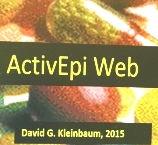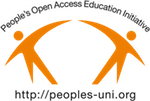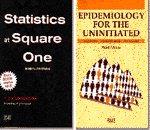Search for most updated materials
JIT, Epidemiology, Education, Global Health and Research Methods
Coronavirus disease (COVID-19) pandemic
Supercourse page with list of scientific book recommended by Supercourse Collaborators.
https://www.jikei-clinicalepi.
Masato Matsushima, MD, MPH, PhD.
Professor and Director
Division of Clinical Epidemiology
Research Center for Medical Sciences
The Jikei University School of Medicine
3-25-8 Nishishimbashi Minato-ku
Tokyo 105-8461
Japan
e-mail: masato@jikei.ac.jp
https://www.jikei-clinicalepi.
New Book - electronic copy of the
publication in Ukrainian.
The book by Mosienko V.S. is autobiographical and medical. It tells about the
path of a surgeon, oncologist, research and development of the drug "blasten"
(as a possible immunomodulator in the treatment of cancer patients with
chemotherapy and radiation, as well as immunodeficiency of various origins).
New message from Supercourse author!
“Epidemic of cardiovascular disease and diabetes. Explaining the phenomenon in South Asians worldwide.”
In addition, I attach a flyer that offers a 30% discount on all three of my OUP books, which I hope that some of your colleagues will find helpful.
Here is a hyperlink to the flyer, in case that is more convenient:
https://www.ed.ac.uk/files/
It is available at a very low price-Rs.620-on Indian Amazon if colleagues are happy with the Kindle version.
I would be delighted to enter into a dialogue with anyone interested about the issues raised in the book, especially but not exclusively on the relatively novel ideas I have introduced e.g. atherosclerosis and possibly type II diabetes as microvascular disorders including through damage to the vasa vasorum; high heat cooking as a source of glycosylated agents that augment the effect of high glucose and damage the endothelium, the pancreas and the kidney, including through increasing arterial stiffness; and the importance of allostasis i.e. the re-setting of normal physiological values through rapid change. Of course, all the usual causal suspects have been examined in some depth.
R S Bhopal, Emeritus Professor of Public Health
Database for QSAR of volatile organic chemicals (VOCs) - Message from Professor Alarie
- The database is for simple chemicals, all volatile organic chemicals of industrial importance. It was published in 1998 (copy attached).
- The total number of chemicals is 145 and divided in two categories, nonreactive volatile organic chemicals (nrVOCs) and reactive volatile organic chemicals (rVOCs).
- Each chemical was evaluated by exposing mice to known concentrations of the vapor of each chemical to obtain a concentration-response relationship for a specific effect. The potency of each chemical was obtained from linear regression analysis and the 50% response intensity was abbreviated RD50.
- This specific effect in mice has been described as “sensory irritation” resulting in a characteristic reflex decrease in respiratory rate due to stimulation of trigeminal nerve endings in the nasal mucosa. The potency, RD50, is the exposure concentration resulting in a decrease in respiratory rate of 50% from normal.
- From this database we have six orders of magnitude in potency (RD50s) for these chemicals, indicating very low to very high potencies.
- From the published 1998 database, you will see that we could obtain a good regression for potency for nrVOCs using physicochemical descriptors, but not for rVOCs.
- In 2015, an article published by Gupta et al. (copy attached) used the 1998 database, but now adding available descriptors for chemical reactivity, they were able to obtain an excellent QSAR for both nrVOCs and rVOCs.
- A 2016 lecture is available from the Society of Toxicology describing the above in details with the correlation of the potency in mice vs. potency in humans, also see below. This is available at the SOT site:
http://www.toxicology.org/
education/edu/eminent.asp At this site, scroll down and click on my name and then on “Recording” to start the lecture. Also you can download each slide as well as Tables 1 and 2 needed for QSAR approaches.
There is one aspect of this 1998 database which is quite important in toxicology for “safe exposure concentration for humans” for regulatory purposes or for emergency situations when such chemicals are released in accidents. Here is a brief summary:
- These chemicals listed in the 1998 database are widely produced, used, stored and transported. The basis for “safe exposure concentration for industrial workers” is sensory irritation. This is usually defined as Threshold Limit Values (TLVs), a list is updated and published yearly since 1946 by the American Conference of Governmental Industrial Hygienists (ACGIH). When the Occupational Safety and Health Act (OSHA) became law in 1970, the 1968 TLVs were adopted as Permissible Exposure Limits (PEL) for regulatory purposes. Other countries are using similar approaches.
- What has been established and published, is that there is a good correlation between a fraction of the RD50 concentration (0.03 x RD50) and the TLV concentration values for these chemicals. Therefore, with a little more work and with results from a QSAR approach, we should be able to eliminate the mouse bioassay and estimate a TLV for humans for new proposed chemicals and for many currently used chemicals for which we do not have a TLV. Provided obviously that they are VOCs.
There is also more information on this bioassay provided at the NTP site following their 2016 request for non-animal methods for acute systemic toxicity:
On this page, scroll down and click on “Request for Data and Information…..”
At the bottom of this page you will see my name with the pdf file.
This file will provide you with a lot of information on what is available and it does also contain a link to the lecture I gave at SOT in 2016.
Another source of information is a recent article by Nielsen and Wolkoff on how sensory irritation results in humans or mice are used to established safe levels of exposure in humans (copy attached)
Let me know if you need more information or any question.
You can get another lecture prepared for students at www.pitt.edu/~rd50 by
Yves C. Alarie, Ph.D. Professor Emeritus University of Pittsburgh Email: rd50@pitt.edu
There are other epidemiology and global health resources available, in the form of
Applying Quantitative Analysis to Development Issues conference https://www.bibalex.org/quantitativeanalysisconference/Home/Home.aspx
 http://www.pcbs.gov.ps/site/lang__en/1005/default.aspx
http://www.pcbs.gov.ps/site/lang__en/1005/default.aspx

ActivEpi Web, a free on-line interactive multi-media textbook on epidemiology concepts and methods.
ActivEpi Web can be accessed at http://activepi.herokuapp.com. The author’s website at http://www.activepi.com provides further details about the sign-up process for ActivEpi as well as freely available supporting materials including Power-Point presentations that can be used for classroom instruction. Also, this latter website describes how to freely access ActivEpi Espanol, which is a translation of the CD ROM into Spanish.
 The
Global Energy Balance Network (GEBN) is a newly formed, voluntary
public-private, not-for-profit organization dedicated to identifying and
implementing innovative solutions – based on the science of energy balance – to
prevent and reduce diseases associated with inactivity, poor nutrition and
obesity.
The
Global Energy Balance Network (GEBN) is a newly formed, voluntary
public-private, not-for-profit organization dedicated to identifying and
implementing innovative solutions – based on the science of energy balance – to
prevent and reduce diseases associated with inactivity, poor nutrition and
obesity.
 Public
Health capacity building in low- to middle-income countries Internet based
online learning using Open Education Resources -
People's Open Access Education
Initiative: Peoples-uni
Public
Health capacity building in low- to middle-income countries Internet based
online learning using Open Education Resources -
People's Open Access Education
Initiative: Peoples-uni
Journals

The
Central Asian Journal of Global Health (CAJGH), Official Journal of the Global
Health Network Supercourse project

NEW JOURNAL - Public Health Reviews
Public Health Reviews was a journal published for approximately 30 years in Israel that has subsequently gone out of print. Our current mission is to relaunch the journal aiming for a broader scope and impact than the original. The journal will be published on a semesterly basis. PHR will be open source, available freely online, with printed copies provided for a fee.
The website is www.publichealthreviews.eu
Conferences and Meetings

Books
- User-Driven Healthcare and Narrative Medicine by Rakesh Biswas and Carmel Mary Martin.
This book contains an article about the Supercourse. - Scientific Networking and the Global Health Network Supercourse, from the NATO Security through Science Series -D: Information and
Communication Security, Volume 5, 2006
Edited by Faina Linkov, Ronald LaPorte - Relearn, Evolve, and Adapt by Supercourse Developer François W. Sauer, M.D.
Other Internet Resources
-
Donnie Dinh (AccreditedOnlineColleges.org) shared a link to their resource web page - http://www.accreditedonlinecolleges.org/health-administration/
-
Population-Environment Open-courseware Resources
11 books curated by TheWecskaopProject
Open-courseware PowerPoints
Biospheric Literacy and Sustainability 101 -
Global Kidney Academy On Line Academy (OLA): www.gkaonlineacademy.com
-
Official launching of NextGenU.org http://www.nextgenu.org/ in preparation for World Health Day April 7th with first courses: Emergency Medicine, Climate Change and Health and Environmental Health.
-
Agent-Based Modeling for Health Policy: Collected Videos, Audio and Slides and
Example Models -
http://www.cs.usask.ca/faculty/ndo885/Classes/ConsensusABM/Lectures.html - Health Administration and Information Technology - http://www.healthadministration.org/healthcare-administration-and-information-technology/
- http://www.global-help.org/
- Toxicology History Association (THA) at http://toxhistory.org
- WHO EMRO - LIBRARY AND INFORMATION NETWORK at http://www.emro.who.int/lin/
- Noncommunicable Diseases and Mental Health at http://www.who.int/nmh/about/en/
- The Global Health Library at http://www.who.int/ghl/en/
- EASD web casts at http://easd.conference2web.com/content
- Relevant links from WWW.NASA.GOV
- The GCMD site at http://gcmd.nasa.gov
- The CEOS IDN site at
http://idn.ceos.org
And choose "Education/Outreach" (as one choice) within the Services query - Connect directly to the Supercourse "SERF" at
http://gcmd.nasa.gov/getserf.htm?PITT_EDU_ENV_SUPERCOURSE
When you are viewing the "SERF", you will note the keywords that you could have used to search within the Services to find your entry ... if you don't have the direct link handy.
- Health Sciences Library

-
 Gresham College, founded by Sir Thomas Gresham in 1597, is an independently funded educational institution based in Barnard's Inn, Holborn, in the centre of London.
Gresham College, founded by Sir Thomas Gresham in 1597, is an independently funded educational institution based in Barnard's Inn, Holborn, in the centre of London.
It provides free public lectures by its eight professors and holds other events. The college does not award degrees or teach courses.
-
 The One Health Initiative concept is a worldwide strategy for expanding interdisciplinary collaborations and communications in all aspects of health care for humans, animals and the environment.
The One Health Initiative concept is a worldwide strategy for expanding interdisciplinary collaborations and communications in all aspects of health care for humans, animals and the environment.
- WWW! March 2009 marks the 20th anniversary of the invention of the Web. Like all great inventions, it arises out of an unmet need that badly needed a solution. Tim Berners-Lee foresaw the great potential that can be unlocked by connecting data across disparate operating systems. You can see the full talk by Tim Berners-Lee as he explains it at: http://www.ted.com/talks/tim_berners_lee_on_the_next_web.html
- The National Resource Center on Advancing Emergency Preparedness for Culturally Diverse Communities
- Resources from the British Medical Journal
 The Supercourse - Global Health Network asked the British Medical Journal
to put two textbooks: Statistics at Square
One and Epidemiology for the Uninitiated upon the
web.
The Supercourse - Global Health Network asked the British Medical Journal
to put two textbooks: Statistics at Square
One and Epidemiology for the Uninitiated upon the
web.
- Other resources from the BMJ:
- BIREME's links
-
 National Library of Medicine
National Library of Medicine
- Dictionary of Epidemiology
- PubMed (free MEDLINE)
- Related Health Services Research Websites I
- Related Health Services Research Websites II
- Grant Writing page
- The 3 lectures at the 38th Annual Meeting of the EASD in Budapest, Hungary and EASD major lectures, namely the Camillo Golgi, Minkowski and Claude Bernard Lectures held at the 18th IDFCongress in Paris in August 2003
- Welcome to MIT's OpenCourseWare
- Google Books http://books.google.com/
